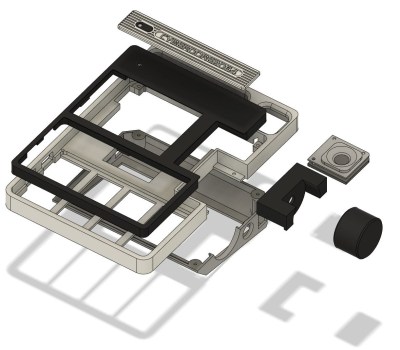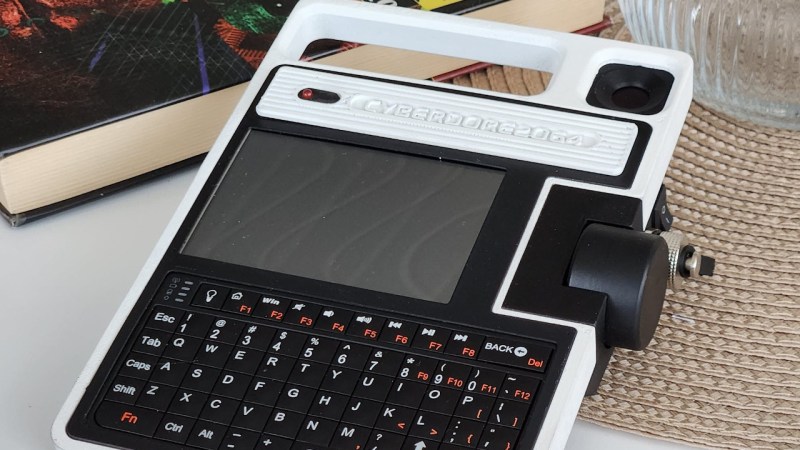It’s difficult to nail down exactly what counts as a “real” cyberdeck in this brave new era of bespoke computing. But at the minimum, most in the community would agree that a proper deck should have a non-traditional form factor, and be designed to meet the unique needs of the builder. If you’re looking for a fantastic example of both concepts, check out the Cyberdore 2064 from [Tommi L].
At first glance the 3D printed enclosure of the Cyberdore looks a bit like a Speak & Spell, but it’s really more of an amalgamation of everything that made 1980s computers so unique. You’ve got the vents, the chunky switches, the undersized display, and of course, the handle. The case might have been extruded in 2024, but it’s doing a fantastic impression of a piece of tech from 40 years ago.
 One of the key external features of the Cyberdore 2064 is the side-mounted rotary encoder that allows for smoothly scrolling through online feeds (such as your favorite hardware hacking site) or long documents. The cheap and easy to work with KY-040 encoder has been converted to a USB input device by way of a Pi Pico, and has been paired with an over-sized 3D printed knob that really makes this build stand out — not only visually, but in terms of usability. These cyberdeck builds often rely on touch screens for input, but we always appreciate a physical interface.
One of the key external features of the Cyberdore 2064 is the side-mounted rotary encoder that allows for smoothly scrolling through online feeds (such as your favorite hardware hacking site) or long documents. The cheap and easy to work with KY-040 encoder has been converted to a USB input device by way of a Pi Pico, and has been paired with an over-sized 3D printed knob that really makes this build stand out — not only visually, but in terms of usability. These cyberdeck builds often rely on touch screens for input, but we always appreciate a physical interface.
Under the hood you’ve got a Raspberry Pi Zero and an 18650 cell to keep the whole thing running while on the go. Though the Zero is certainly showing its age compared to the more modern variants of the Pi, for a device like this, raw computing power isn’t really the driving concern. A mechanical keyboard usually rounds out these cyberdeck builds, but in this case, [Tommi] went with a fairly common Rii 518BT portable board that’s been skillfully integrated into the front of the Cyberdore.
All of the STL files necessary to print out your own Cyberdore 2064 are available on Printables, and while [Tommi] didn’t exactly provide build instructions, the write-up provides plenty of information to get you started.
So is it just us, or does looking at Cyberdore 2064 make you think it’s time for another Hackaday Cyberdeck Challenge?
















This thing seems pretty darn neat, somewhere between a calculator, portable terminal and just a regular computer… I can see something like that sitting on my desk and even though I hate those little keyboards it would end up getting lots of use I expect… I think I’d have wanted to look for a way to squeeze RF or cellular connectivity into it, looks like it would be possible, and I’d definitely want to put one of the decent audio card options on it myself.
And once again makes me want to build. Though actually getting the time and space to make the ‘cyberdecks’ I have in my head…
I still miss carrying handles on notebooks…
《Snort》Compaq Portable ?
No Toshiba T1000…
http://blogger.googleusercontent.com/img/b/R29vZ2xl/AVvXsEhIBmk7k-HpfFPGENm262QxlDEI2nt4GZZ2okCXqmu_K7j8QcX8KGXxghmAGdhEBB9GzFxX4roMGd3nMjDDt0wTaR8xl6guW9YMUshLE6kzoGwmIENa9Uvk
ALL of them missed the mark. To see what a portable computer in the 1980s should have looked like, look at an HP 495x Protocol Analyzer. These had a serious handle and flip-down keyboard. https://github.com/hughpyle/HP4952A
“most in the community would agree that a proper deck should have a non-traditional form factor,”
I never thought of the form factor before defining cyberdecks, until you wrote it down. But yes!
I’ve always thought it kind of has to be right? Otherwise the modern laptop is effectively the ‘cyberdeck’ perfected minus the whacky mis-predictions like that we’d all be using head mounted displays by now.
I think this is especially noticeable with cyberdecks that “open” (think all the ones built into Pelican cases for example) to present a screen on the top half and keyboard on the bottom.
“the modern laptop is effectively the cyberdeck perfected” – imo you really put your finger on it!
for more than a decade now i’ve had a series of extremely cheap and generic laptops that i’ve been extremely satisfied with (before that, i was always dissatisfied). the only thing special when i shop for laptops is i specifically get the lowest specs because who wants to convert watts into computation right in their lap when the network exists? the network is the computer.
the idea in the gibson books is that the cyberdeck is highly customized. an individualized interface, for maximum efficacy for specific unusual users. but it turns out, it’s not the hardware that’s special, but rather the software. even though i buy the same cheapest laptop that is targetted at k-12 schools, it is anything but a generic user experience. i heavily customize the software.
anyways that’s also why i cringe whenever someone uses the raspberry pi. when i think about the flaws with mainstream laptops that desperately need to be corrected, poor battery life and poor suspend modes comes to mind. it’s not just on the list, and it’s not just on the top of the list: it’s almost the entire list. i used an ibook — which is really awful in a lot of ways — for 6 years just because it was the only laptop you could buy at the time that *ACTUALLY* suspended. in 2024, after suspend and 10 hour battery life has become industry standard for such a long time that you take it for granted, to think “gee i want to customize a computer and the first thing i want to do different than the mainstream is awful battery life and reboot every time i close the lid” really shows to me the deep unseriousness of it.
Really depends on just what you want doesn’t it – I had a laptop for many years that despite weighing in at I think was about 8 Kg, might even have been more, it was certainly very heavy (largely in battery followed by cooling). Yet despite that battery being so large that it definitely wouldn’t be allowed to fly now it would still last bugger all time – the battery was more a UPS and allowed the machine to be very flexible in use location, just get up and move wherever you want to… Think the best I ever got away from the wall was 2 and change hours…
But for me at the time as my room was tiny and would get stupidly hot it was ideal at home -set up anywhere and get out of the way painlessly, and good for dragging to my ‘educational facility’ (in quotes because honestly I spent more time playing an asteroids clone or racing games than the lessons, or just doing the homework if I had any to do). So despite all the downsides it was still a really great machine and was the best choice I could find (in my budget) for me at the time – desktop class CPU, with sufficient cooling back when laptops generally came with such anaemic processors they were only good for the lightest of light workload users, those with massively more patience than I had, or those with access to big servers to do the real work somewhere else…
And similarly many of these cyberdecks have great niches that a normal laptop doesn’t have, the laptops of today trending towards having very limited I/O being general purpose machines that frequently aim for thin and light, so you only need two hopefully all singing and dancing alt-mode filled USB-C ports right? Which means these days a laptop tends to be cats cradle of dongle to actually get the ports you need. So while many of these cyberdeck are clearly more about having fun than any practical use some are simply the right tool for somebody’s specific needs, and some you can argue are in the middle ground of not so uniquely perfect as to accept no rivials, yet they perfectly functional- which is about where I’d argue this form factor and hardware falls.
In this case it is a desk calculator style footprint that for me would be ideal to sit on my normal desk, get in the way much less than a laptop at least on my desk – the clamshell screen would just be in the way, but with it closed the machine really wouldn’t be very useful… So while I’d make some changes, even as it is it would be a useful to me in a way my laptop rarely is – the always on terminal, music player, graphic calculator, maybe even remote volume control etc of other devices. And it will still last plenty of time on battery when you want to take it somewhere. Sure it doesn’t even come close to having the same performance as the best AMD, Apple and now Qualcomm are showing up with (Sorry Intel but atm for performance:efficiency at least doesn’t look like you have anything really in the running). But if all you need is a computer like object not a kernel recompiling beast and you like me really really hate the user experience of smartphones that are all touchscreen etc then the lack of performance for its power draw really doesn’t matter much, and its power draw is pretty darn low, so the battery can still last a good long while…
Or in short Nothing wrong with a Pi in the right place, and that can be in a very practical cyberdeck type build – may not be doing the job you want as well as a laptop would, but it can be doing everything it needs it to do perfectly for the task it was meant for…
” and easy to work with KY-040 encoder”
For some reason, a different KY-40 came to mind when I read that.
And not confused with a K-40.
Yeah, another challenge would be cool.
Just give us procrastinators a year or more warning before actually starting the contest!
B^)
Should have called it “Sneak & Spell”
I award you “One Internet Merit*”!
*Redeemable for merchandise listed in any pre-1960 Spiegel catalog!
The rotary encoder reminds me of a Rolodex so why not call this the Rolodeck? Now just to make it dispense Rolos.
This looks fantastic
Wait, which part is the main display?
Um. The big gray rectangular area?
Which part number. I can see the screen in the photos
I used the basic Raspberry Pi 3.5″ LCD display hat with 480×320 resolution for this. More specifically the Waveshare’s “3.5inch RPi LCD (A)” model. It has a bad refresh rate so definitely will try some other options for the next cyberdeck builds.
I want a cyberdeck in a TI-84+SE shell. I sadly lack the knowledge and skill to achieve this. Alas, I can dream…
Looks great!
The Speak-n-Spell vibe really works here, and the keyboard is so well integrated, I didn’t realize it’s an off-the-shelf keyboard with 8mm keys.
Oh yes, I avoided the build-it-yourself keyboard trouble by designing the casing around that Rii keyboard :) I tested various micro keyboards, but the Rii had the best typing experience – kind of like an old Nokia N900 keyboard.